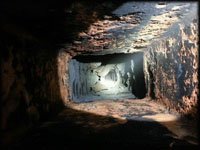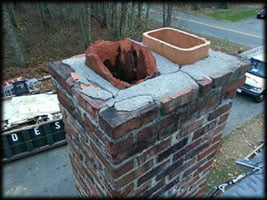Chimney Sweeping
The Chimney Chap services and cleans wood-burning fireplaces, woodstoves, woodstove inserts, gas fireplaces, pre-fab fireplaces, and gas and oil furnace flues. All of our chimney sweeps include a Level I Inspection. The National Fire Protection Association Standard 211 says, “Chimneys, fireplaces, and vents shall be inspected at least once a year for soundness, freedom from deposits, and correct clearances. Cleaning, maintenance, and repairs shall be done if necessary.” This is the national safety standard and is the correct way to approach the problem. It takes into account the fact that even if you don’t use your chimney much, animals may build nests in the flue or there may be other types of deterioration that could make the chimney unsafe to use.
The Chimney Safety Institute of America recommends that open masonry fireplaces should be cleaned at 1/8″ of sooty buildup, and sooner if there is any glaze present in the system. Factory-built fireplaces should be cleaned when any appreciable buildup occurs. This is considered to be enough fuel buildup to cause a chimney fire capable of damaging the chimney or spreading to the home.
The Chimney Safety Institute of America issues its annual chimney inspection reminder. Both the CSIA and the National Fire Protection Association recommend annual chimney sweeping by a qualified professional .
“Don’t think that just because you have not used your chimney lately that it is ready to go,” reminds Ashley Eldridge, CSIA’s Director of Education. “Any variety of things, such as animals, can get into your chimney in the off-season.”
According to the most recent statistics from the Consumer Product Safety Commission, an average of 25,100 chimney fires are responsible for 30 deaths and $126.1 million in property damage on average each year.
Furnace Flue Cleaning
The incomplete by-product of combustion of fuel oil is unburned carbon and sulphur – called oil soot. Oil soot accumulates on the walls and at the base of the chimney, which should be inspected and cleaned annually by a CSIA certified chimney sweep.
Most homeowners are unaware that the chimney venting system for the furnace needs maintenance. Most find out after the chimneys are clogged, or the interior collapses, that they need a chimney technician. It is usually too late for a routine cleaning at this point and homeowners are stuck with emergency service call costs and blockage removals or repairs in order to get the heat and hot-water turned back on. This could be avoided by routine maintenance and inspections of the furnace chimneys.
 The best time of the year to clean an oil chimney is in the spring time, after the heating season. During the winter, the oil furnace is subjected to long running cycles, which will produce oil soot that may adhere to the sides of the chimney. The accumulation of these soot deposits will fall to the base of a masonry chimney, or directly into the top of the oil furnace if a metal chimney is located directly above the appliance. It will restrict the flow of flue gases, which consist mostly of nitrogen, carbon dioxide, and water vapor. Combustion will also produce carbon monoxide (which is a dangerous gas when not vented properly), which will spill back into the house instead of going up the chimney when the chimney base is not properly cleaned.
The best time of the year to clean an oil chimney is in the spring time, after the heating season. During the winter, the oil furnace is subjected to long running cycles, which will produce oil soot that may adhere to the sides of the chimney. The accumulation of these soot deposits will fall to the base of a masonry chimney, or directly into the top of the oil furnace if a metal chimney is located directly above the appliance. It will restrict the flow of flue gases, which consist mostly of nitrogen, carbon dioxide, and water vapor. Combustion will also produce carbon monoxide (which is a dangerous gas when not vented properly), which will spill back into the house instead of going up the chimney when the chimney base is not properly cleaned.
A big misconception on many homeowners’ part is that the oil service company takes care of the chimney. The oil burner company may shovel out the base of a brick chimney and brush out the connector pipes, but they will not clean the chimney. Most furnace technicians fail to mention anything about the chimney leading homeowners to believe everything is fine. Some oil furnaces service men even tell the homeowner that the chimney is OK without inspecting the entire chimney, which includes going to the roof and inspecting the interior as well as the exterior masonry (if applicable), flashing, chimney cap, etc.
 Many homeowners also may not be aware that the chimney’s interior, when not maintained, will decay and break down – just like neglecting your teeth and not having them checked annually may result in cavities. It’s the same thing with your chimney. As stated earlier, the incomplete by-product of combustion is soot, which contains carbon and sulphur. Sulphur, when mixed with rain water (from a missing chimney cap) or moisture from the flue gases themselves is absorbed into the flue tile and starts a deteriorating process called flaking or spalling.
Many homeowners also may not be aware that the chimney’s interior, when not maintained, will decay and break down – just like neglecting your teeth and not having them checked annually may result in cavities. It’s the same thing with your chimney. As stated earlier, the incomplete by-product of combustion is soot, which contains carbon and sulphur. Sulphur, when mixed with rain water (from a missing chimney cap) or moisture from the flue gases themselves is absorbed into the flue tile and starts a deteriorating process called flaking or spalling.
In metal chimneys, the interior lining is made from stainless steel, which will not rust, but will corrode from the oil soot’s sulfuric acid reaction. This corrosion makes small pinholes, which will ruin the integrity of the liner, which will not be able to hold the by-products of combustion. When a clay lining in a masonry chimney flakes or a metal chimney’s insides corrode, they are unable to contain the heat and the flue gases, thus creating a potential fire and health hazard.
In regards to your furnace flue, the un-burned bi-products of the gas and oil leave a corrosive substance on the inner wall of the flue. If these un-burned bi-products of the gas are not removed they will begin to deteriorate the masonry and or metal flue. If the metal or masonry flue develops a hole this can lead to carbon monoxide leaking into the home. Carbon monoxide is odorless and tasteless, and is often called the “silent killer” due to the fact that you are unaware of its presence in your home. It is especially deadly in the winter months, because all of the windows are closed, so the carbon monoxide has no place to escape. And we do emphasize deadly.
No Mess Hassle..
The number one concern about having chimney sweepers in your home is the mess that is envisioned. However; THERE IS ABSOLUTELY NO MESS! That’s right! There is no mess and just in case you are interested in how we do that, here are the steps we take to make sure that your home is as clean, if not cleaner, after the job is complete.
- We lay tarps out in front of the fireplace to insure that your carpet doesn’t get dirty and then set up a high speed dust collector to make sure that no soot gets into your home.
- We sweep the inside of your chimney, from the firebox floor to the chimney top.
- We then clean, inspect and adjust the damper and damper assembly.
- We use brushes on rods to sweep the flue, hand brushes for the firebox and smoke chamber, and a vacuum with a triple layer HEPA filter to control dust.
- After doing all this we then do a visual inspection of the outside of the chimney, checking the mortar work, brickwork and crown. Any damage or needed repairs we find is documented on video or with digital photos that can be sent to you.
- When we are through we will leave with you a copy of the written evaluation.
- We have a 100% satisfaction guarantee on our workmanship.
- We recommended this service to be done annually.

